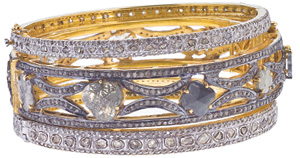
|
Diamond slice cuff stacked with rose cut diamond bangles, from Forever Creations USA.
|
In India, jewelry is in the genes,” observes Ajit Bardia,
owner of House of Silver in Jaipur, India, doing business in the U.S. as
Forever Creations, USA. “In India, the business transfers from generation to
generation.” Ajit learned the jewelry business from his grandfather, Kaylan mal
Bardia, who had an eponymous firm in Jaipur, selling gold and silver bars back
in the 1930s. “At that time, people liked to save the metals, not wear them. It
was before India’s independence from Great Britain.”
From the time he was ten years old, Ajit would go to the
Jaipur factory with his grandfather and father during school vacations,
learning different aspects of the trade. At night, the three would come home
and talk about the business. That is how the jewelry business is taught in
India, he explains. During this time Ajit’s father, Umaid mal Bardia, was in
Bombay, now known as Mumbai, exporting emeralds and other gems as a division of
his father’s firm. In 1978, Umaid began to produce jewelry and 11 years later,
in 1989, the family entered the U.S. market. Their first foray in the U.S. was
to the American Gem Trade Association (AGTA) GemFair held in Tucson, Arizona.
Soon after, the firm opened an office in New York City.
“Everyone wants the U.S. Here, the jewelry market is big,”
says Ajit, sitting in the family’s Forever Creations USA office on 47th Street
in New York City, which is managed by his son Amit Bardia. Amit learned the
jewelry business in the same way as Ajit — with one big difference. In 2003
Amit came to New York to study finance at Pace University. During school
breaks, Amit would return to Jaipur where he would go to the family factory
every day, learning the various aspects of production. In the evenings, Amit
and his grandfather Umaid and father Ajit would sit up talking about the
business and how it is run and how it works. The family’s jewelry factory in
Jaipur has some 30 divisions and over 500 employees. Each of the divisions
specializes in a different aspect of jewelry production.
At around that same time, the diamond business was changing.
“Single cut diamond and silver jewelry was coming up,” says Ajit. “It was
something new for the diamond business. The jewelry was inexpensive and it
looked good.”
According to Ajit, the business expanded quickly after Amit
joined the firm. His computer savvy helped to grow the business. “Communication
became easier,” says Amit. “When we worked with jewelry stores here in the
U.S., it was easier to communicate what they wanted us to do to our factory in
Jaipur.” Amit did many trade shows and developed a strong clientele that helped
to expand the business
All five members of Ajit’s family are part of the company.
His wife Madhu Bardia travels with her husband to trade shows and works in the
booth. His daughter Ankita Bardia oversees production and design at the Jaipur
factory and his daughter-in-law, Nikita Bardia, who is married to Amit, is head
of marketing and helps in the design of the jewelry. Based on what is selling
and customer feedback, Ankita and Nikita create renderings of jewelry that are
sent back to the Jaipur factory where the designers use computer-aided design
(CAD) to tweak the design to fit the stones they have available for
manufacture. “We introduce a few designs per show and if we get a good
response, we mass-produce that item,” comments Amit. “These days, things move
fast. Something sells for six months and then it stops selling. We have to keep
coming up with new designs or our customers lose interest.”
Forever Creations USA uses a lot of rose cut diamonds and
slices in their collections. “Using the concept of rose cut diamonds with an
antique look, we have taken many Indian designs and then modernized them for
the Western market,” says Ajit, who notes that rose cut diamonds are becoming
more popular in other parts of the world, including South America, Mexico,
Europe and Canada. “Slices and gray diamonds are very popular because they are
very good prices,” comments Ajit.
The family goes to a trade show every month and continues to
take their jewelry story — one of history and tradition blended with the modern
world — into new markets.
Article from the Rapaport Magazine - August 2013. To subscribe click here.